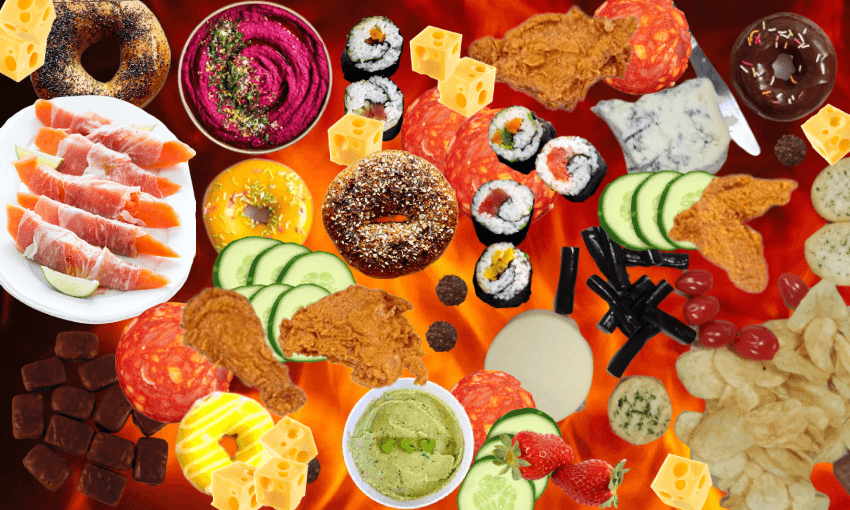Ten thousand years ago, roasted hares and figs were flat-layed on Levantine flax leaves. Now, we drape prosciutto over strawberries on computer desks. Josie Adams mourns the death of the platter.
Three days ago I stumbled on an accidental recreation of a 1950s platter: a giant ham, a cake that was mostly icing, and pickled onions that were so poorly lit so I thought they were massive olives and ate one whole. This was the best platter I’d seen in a long time.
For millennia we got it right. The key elements were always there: bread, grapes, olives and cheese; cold cuts, pearls and fruit tarts were optional additions. Dessert platters, too, abounded in both the halls of Louis XVI and the gardens of ancient Eridu. Small cakes, fresh fruit and halva were decorated with sugared almonds or edible flowers.
Now, we scatter pineapple lumps around beetroot hummus in sad, childish rings.
The descent into grazing hell began in the 19th century, when jelly was invented. Soon, every party food was à la gel. Aspic, a savoury jelly made with meat stock, dominated the dark ages of party cuisine: the 1870s through to the 1970s. Fish, shrimp and entire salads were encased in it.
A “nice spread” in the 60s was tinned asparagus rolls, devilled egg, devilled ham, and the devil’s own devilled anus. The people who made them were too far removed from the glory days to remember the delight of non-devilled foods, and the wars had left them obsessed with tinned vegetables. This is probably why boomers are like that.
As we entered the 1980s and tried to redefine grazing platters to be less “surprise egg” and more “heard of hummus?”, a brief golden age dawned. White people heard about nachos. We gradually released the pineapple and cheese hedgehogs of the ’70s back into the ether.
We worked out some bread and cheese kinks – gluggy fondues, damp club sandwiches – and by the time the ’90s came around the platter was restored to health. Stuffed portobellos, mini muffins and saveloys were fresh takes on classic platter elements. Luncheon sausage, a proto-chorizo, was paired with thick squares of edam and cheddar.
Over the next decade cured meat got less disgusting, and olives and grapes came back into fashion. Focaccia and ciabatta began to rise, and in the West we learned that you’re supposed to put tahini in hummus. A wheel of brie was mandatory at every meeting of more than three people. Parties were better than they’d been for 200 years.
We platter lovers had nearly two good decades, but it’s over now. In the past year I have seen a giant stack of pancakes sitting amidst tens of kilos of slowly melting chocolate and candy floss, all untouched for influencers’ fear of getting sticky. I have witnessed half a packet of Tim Tams balanced atop a giant truckle of gruyère. I have eaten too many beetroot hummuses, each one with an inappropriate vehicle: a nacho chip, a salt-and-vinegar rice cracker, a raisin bread. I have gazed on fried chicken nestled next to a tower of Ferrero Rocher, both of which are delicious foods but should not be touching. I have wept at heads of hydrangea, a very not-edible flower, sitting on bagels and whole cucumbers.
We have gone mad with power. We can make anything: cronuts, gold leaf burgers, soylent. And when we have too many options, we lose our nut. We throw them all together, desperate for partygoers to see how many cheese names we know and how many wooden doughnut hangers we can afford.
It’s gratuitous. It’s disgusting and extravagant. Office benches are groaning under the weight of guacummus paired with artisan liquorice and chicken sushi. I saw Spinoff boss Duncan Greive scoop an entire tablespoon of wasabi onto his sushi because he thought it was avocado. Why would he put avocado on sushi? I’ll tell you for why: his pairing senses are assaulted every day by a new Frankensteinian platter. No, he wasn’t OK. He was really upset.
Please, I beg all platter artists: stop this. I’m not telling you what to do, but won’t someone think of Duncan? Won’t someone think of the pancakes falling apart, uneaten, in a puddle of chocolate juice?
Stick to a theme and, for the love of God, separate your sweets and savouries. Stop putting chocolates in every available gap. That salt/sugar complimentary thing should be left to professionals and popcorn. I promise no one will notice there’s a sliver of table visible in your bagel holes.



